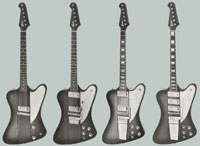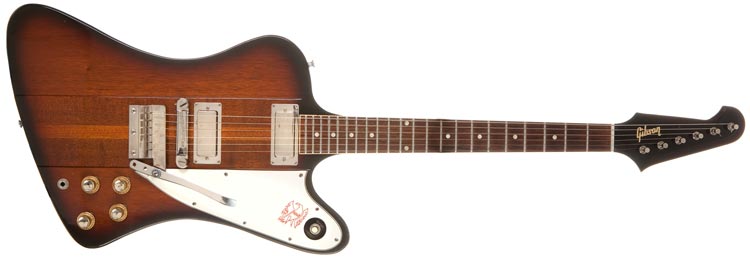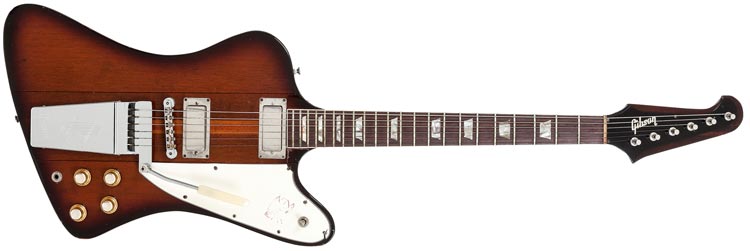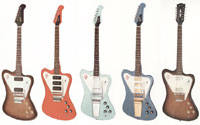

Gibson Firebirds - as advertised in the 1964 Gibson catalogue
"Bright - Vital - Fast ... the leaders in modern sound". The Gibson Firebird is another of those iconic Gibson guitar designs that is inseparable from the history of rock music. They were not immediately popular, despite being adopted by big stars of the day like Brian Jones and Keith Richards of the Rolling Stones but like so many other Gibson guitars, their appeal snowballed; today the Firebird is a standard part of the Gibson line. As the 1963 advertising suggests, they have a distinct bright and punchy tone, a contrast to the slightly darker tones produced by the larger PAF humbuckers. Like any vintage Gibson, they are great playing instruments, very collectable and command high prices - five figure sums are common for early examples, guitars in great condition, or those with a custom finish. If you see a vintage Gibson Firebird for sale at an affordable price, snap it up.
The Firebird launched in the second half of 1963, without causing too much of a stir. In some ways was it was a descendant of the commercially unpopular Explorer; it had a similar 'reverse' body style (but with far more curves), and likewise didn't catch on with the public until some years after the original guitars were sold. It was designed by car designer Ray Dietrich, who was resident in Kalamazoo, where the Gibson plant was situated. Dietrich was at the end of his career at this point, but had designed vehicles for numerous manufacturers throughout the first half of the 20th century. But like the Explorer and Flying V, the Firebird design was perhaps a little too futuristic. All production occurred at Gibson's Kalamazoo plant in Michigan, USA. It was initially launched in four variants, Firebird I, Firebird III, Firebird V and Firebird VII, with two similar bass models (the Thunderbird II and IV). All were mahogany bodied with a neck-through construction. Necks were initially mahogany, fingerboards Brazilian rosewood (ebony for the Firebird VII). All models sported the same 'high performance' mini-humbucking pickups. 44 1/2" long, 14 1/2" wide, 1 1/2" deep. 22 frets, with a standard Gibson 24 3/4" scale. Sunburst finish was as standard, though custom colors were immediately available (at a slight premium) though these are certainly less often seen than Sunburst examples.
Although today seen as a rock instrument (largely because of the shape), it was initially pitched as a jazz guitar. The following text comes from both 1963 and 1966 Gibson Firebird literature
The Firebird series were first included in the Gibson price list of July 1963. Detailed specifications and original pricing for each model can be found here
 Image Heritage auctions
Image Heritage auctions
The new solid body by Gibson that is priced for the growing economy-minded market. Gives you all of the fine performance of this exciting new series of guitars at a price you can afford. You have to try it to believe it
The Firebird I was equipped with a single mini-humbucker with one volume and tone control. Dot neck markers, unbound fretboard. July 1963 list price $189.50, $15 extra for Duco custom colors.
 Image Heritage auctions
Image Heritage auctions
A solid performer in this new line up of solid body guitars from Gibson. Offers you all the range and versatility that you could ask for, plus that sharpness in the treble range, and deep biting bass.
The Firebird III was equipped with dual mini-humbuckers, with volume and tone controls for each pickup, three-way pickup selector switch, Gibson Vibrola, dot position markers and a bound fretboard. July 1963 list price $249.50, $15 extra for Duco custom colors.
 Image Heritage auctions
Image Heritage auctions
Another in this revolutionary new series of solid body guitars by Gibson. Exciting in concept, exciting to play. You find a whole new world of sound and performance potential on this fine instrument
Like the Firebird III, the Firebird V had two mini-humbuckers, but somewhat nicer appointments: Deluxe Vibrola, tune-o-matic bridge, and trapezoid pearloid inlays. July 1963 list price $325, $15 extra for Duco custom colors.
 Image Heritage auctions
Image Heritage auctions
Here is the ultimate in a solid body guitar by Gibson. A completely new and exciting instrument that offers all the sound, response, fast action and wide range that could be desired.
The Firebird VII was the most ornate of all the Firebirds. It had large pearl block inlays in an ebony fretboard, three mini-humbuckers, and gold plated hardware throughout. July 1963 list price $445, $15 extra for Duco custom colors.
| Firebird, all models* | SG, all models** | |
| 1963 | 434 | 5797 |
| 1964 | 2434 | 7419 |
| 1965 | 2283 | 8871 |
| 1966 | 2735 | 5517 |
| 1967 | 779 | 4005 |
| 1968 | 271 | 3680 |
| 1969 | 83 | 6934 |
Gibson custom colors available on the Firebird and Thunderbird models were as follows: Cardinal Red, Heather poly, Inverness Green poly, Ember Red, Polaris White, Pelham Blue poly, Frost Blue, Kerry Green, Silver Mist poly, Gold Mist poly. Although shipping data does not specify the number of custom finish Firebirds, it is safe to assume that these were shipped in vastly smaller numbers than those in the standard Sunburst. It is quite possible that some Firebird variants were never available in some of these colors.
The original reverse body version of the Firebird was only manufactured from 1963 to 1965, but sales, although not that small, but were low compared to other models. The peak year of the reverse body Firebird was 1964, though sales were still only a third of SG sales in the same year.

Gibson Firebirds - as advertised in the 1966 Gibson catalogue
In 1965 the instrument was relaunched with a new body shape and set neck (rather than through neck from older models) construction. This was known as the non-reverse Firebird. In addition to the existing models, a 12-string Firebird was also produced. The Firebird I and II were now equipped with P90 single coil soapbars - the humbuckers only on the V, VII and V-12. The first price-list inclusion of the non-reverse Firebirds was in June 1965. All models actually decreased in price from the previous (February 1965) listing.
 Image Heritage auctions
Image Heritage auctions
The non-reverse Firebird I was significantly better equipped than the reverse body model, with two P90 single coil pickups, each with volume and tone control, and a Gibson vibrato. The June 1965 list price was just $189.50, $15 extra for Duco custom colors - the same price as the single pickup reverse body Firebird I two years earlier.
 Image Heritage auctions
Image Heritage auctions
The non-reverse Firebird III was fitted with three P90 single coil pickups. The June 1965 list price was $239.50, $15 extra for Duco custom colors.
 Image Heritage auctions
Image Heritage auctions
The non-reverse Firebird V was functionally identical to it's reverse body equivalent, but less ornate: it had no neck binding, and just simple dot position markers. The June 1965 list price was $289.50, $15 extra for Duco custom colors.

The Firebird V 12 string had the same features (except vibrola) as the Firebird V, but a slightly higher price. The June 1965 list price was $309.50, $15 extra for Duco custom colors.

Again, the non-reverse Firebird VII had somewhat lesser appointments than it's reverse body predecessor. The fretboard had simple dot inlays, and was now rosewood as opposed to Ebony . The June 1965 list price for this model was $379.50, with $15 extra for Duco custom colors.
The instruments were manufactured from 1965 until 1967, but were still being shipped as late as 1969. Despite a tiny rise in 1966, sales can only be described as dreadful. It was no surprise that the Firebird was quickly deleted from the Gibson line.
Gibson Firebird III - Some Guitarists Have All the Fun
1968 Guitar Player advert featuring examples of much of Gibson's late 1960s range: the Gibson B25-12 flattop acoustic, GSS-100 solid-state amplifier, and two electrics, the solid-body Firebird III and the hollow-body ES-330TD. This was one of the first Gibson advertisements not to focus on high-end jazz guitars, or famous musicians, rather instruments more likely to appeal to the general guitar-buying public.
The layout of this advertisement takes it's styling from the then current catalogue (the 1966 Gibson full-line).
In 1972, a few more Firebirds were produced. These reverse body guitars were known as the 'medallion' Firebirds, made to celebrate the 1972 Olympic games. A Medallion Flying V was also reissued at the same time. These were limited edition instruments, made in very small numbers, and have a numbered medallion attached to the body. Just 366 of these guitars were produced between 1972 and 1973.
The Firebird (along with the Thunderbird) was reissued once again during the 1970s, again as a celebration/commemoration - this time the bicentennial anniversary of the creation of America. The Firebird logo on the scratchplate was in red white and blue. This issue never outsold the 1960s versions, but still sold in significant numbers, especially in 1978. Oddly this guitar never appeared in any US Gibson catalog or price list, though it did appear in the New Models 1977 brochure, printed in the United Kingdom. Why this was the case is not clear, however a Firebird with identical specifications (save the Firebird logo) was included amongst numerous other models in the 1981 Gibson Specials folder.
The Firebird II was a short-lived limited edition model, only produced briefly between mid 1981 and early 1982. It was first described in the 1981 Gibson Specials folder, but never made it to a US catalog proper. It was, however, shown in the Japanese (Arai) Gibson and Epiphone catalog (probably late 1981), and the UK (Rosetti) 1982 catalog. It was listed in US price lists (January and June 1982) at $999, and was gone by 1983.
In terms of specifications it was quite unlike the regular Firebird, having a bound maple body with figured maple veneer top, and set maple neck, and upgraded hardware such as the TP-6 bridge. It also had the same active series VI pickups, and Moog circuitry (bright mode and expansion/compression) of the RD Artist.
As is shown below, the Firebird decreased in popularity (as determined by sales) throughout the period 1963-79. The production figures show the most abundant Firebird are:
early 60s reverse-body models (63-65) - 5151
mid 60s non-reverse models (65-69) - 3868
late 70s bicentennial Firebird (76-79) - 2847
early 70s medallion Firebird (72-73) - 366
In fact the change from reverse to non-reverse body happened in mid 1965, so some of the 5151 instruments shipped that year may have actually been no-reverse bodies.
The separate shipping totals for all Firebird models, 1963-1979 are as follows
| Firebird I | Firebird III | Firebird V | Firebird V-12 | Firebird VII | TOTAL | |
| 1963 | 80 | 272 | 62 | 20 | 434 | |
| 1964 | 497 | 1254 | 510 | 173 | 2434 | |
| 1965 | 800 | 1020 | 353 | 110 | 2283 | |
| 1966 | 1164 | 935 | 342 | 248 | 46 | 2735 |
| 1967 | 200 | 463 | 83 | 24 | 9 | 779 |
| 1968 | 192 | 10 | 50 | 19 | 271 | |
| 1969 | 34 | 27 | 17 | 5 | 83 | |
| total | 2967 | 3981 | 1417 | 272 | 382 | 9019 |
| Firebird V medallion | Bicentennial Ebony | Bicentennial Natural | Bicentennial Tobacco Sunburst | Bicentennial White | TOTAL | |
| 1972 | 351 | 351 | ||||
| 1973 | 15 | 15 | ||||
| 1976 | 222 | 268 | 25 | 27 | 542 | |
| 1977 | 259 | 215 | 160 | 67 | 701 | |
| 1978 | 796 | 644 | 16 | 1456 | ||
| 1979 | 127 | 14 | 7 | 148 | ||
| total | 366 | 1277 | 1254 | 199 | 117 | 3213 |
$3849
$5500
$34900
$3997
$6825
$5200
$10000
$17000
$4499
$8808
$349
$599
$1480
$27900
€575
€8700
€499
£397